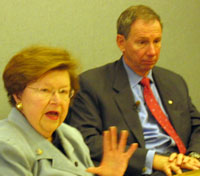 |
|
|
Politics
Main Page |
|
Hubble Telescope to Get a Makeover
By Melissa Pachikara GREENBELT, Md. - NASA's Hubble Space Telescope will be getting a final makeover in 2008. Seven space shuttle astronauts will take two new instruments to the telescope in a mission designed to extend the life of the powerful observatory through 2013, NASA Administrator Michael Griffin announced Tuesday. Orbiting Earth about every 97 minutes, the 43-foot tall telescope collects images and data that have allowed scientists to map and study space like never before. Using powerful instruments, Hubble has been their tour guide, introducing scientists to new galaxies and teaching them about the evolution, structure and intricacies of the universe. "Literally thousands of scientists around the world use it regularly," said David Leckrone, senior scientist for Hubble. A servicing mission had been planned for 2004 but was put on hold out of safety concerns in the wake of the Feb. 1, 2003, Space Shuttle Columbia explosion. Columbia was destroyed during re-entry, and its crew perished. Hubble's last servicing mission - its fourth - was in March 2002. Sen. Barbara Mikulski (D-Md.) joined Griffin at the Goddard Space Flight Center announcement. She and Griffin both emphasized that the decision was made with the utmost concern for the safety of the astronauts. "I will move heaven, earth, this galaxy and even those unknown to make sure there is money in the budget to always protect our astronauts," Mikulski said. During the planned 11-day mission, the astronauts will be installing a Cosmic Origins Spectrograph and a Wide Field Camera 3, instruments that will improve Hubble's ability to "see" in outer space. They will also be performing repairs on an existing space telescope imaging spectrograph, which stopped functioning in August 2004. The trip is estimated to cost $900 million, Griffin said. That includes $500 million for engineering support, $200 million for the cost of the two new instruments and about $200 million to launch the mission.The additions and repairs will require the astronauts to make a series of space walks. Griffin noted another orbiter would be kept ready for a rescue mission if needed. Hubble has had a turbulent history since its 1990 debut in space, when NASA discovered that a large mirror in the Hubble apparatus was flawed. "Word came back that Hubble couldn’t see, and it needed the most expensive contact lens in world history," Mikulski said, reflecting on that time. The corrective optics were added in December 1993. After the Columbia disaster, the fate of Hubble was uncertain. On Jan. 16, 2004, NASA Administrator Sean O'Keefe had decided to cancel all future servicing missions for Hubble. Mikulski said she persuaded then-administrator O'Keefe to get a second opinion before succumbing to a terminal diagnosis for Hubble. That second opinion was led by Adm. Hal Gehman, who also chaired the Columbia Accident Investigation Board. His report was inconclusive about whether to go ahead with servicing because further technical information was needed. Congress funded further study, including an evaluation of whether a robotic mission to service Hubble would work. A robotic mission was eventually ruled out. Mikulski has supported funding for the Hubble servicing mission, including $350 million that had been appropriated during fiscal years 2005 and 2006. Mikulski noted that she and Sen. Kay Bailey Hutchinson (R-Texas) would also be introducing an appropriations bill for $1 billion to help NASA recoup some of the lost costs from the Space Shuttle Columbia tragedy. "Hubble is the telescope that keeps giving," Mikulski said, describing how it opens opportunities to science and discovery. Griffin agreed and noted that Hubble will leave a rich legacy. "No doubt, two generations from now, graduate students will be studying data from Hubble," he said. Leckrone said that Hubble has not yet reached the limits of what it could do. After the 2008 servicing mission, Hubble "will be at the apex of its capabilities," he said.
Last updated: 11/02/06 09:11 AM Copyright © 2006 University of Maryland Philip Merrill College of Journalism |

